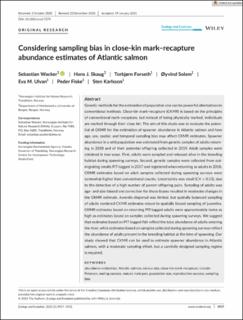| dc.contributor.author | Wacker, Sebastian | |
| dc.contributor.author | Skaug, Hans Julius | |
| dc.contributor.author | Forseth, Torbjørn | |
| dc.contributor.author | Solem, Øyvind | |
| dc.contributor.author | Ulvan, Eva Marita | |
| dc.contributor.author | Fiske, Peder | |
| dc.contributor.author | Karlsson, Sten | |
| dc.coverage.spatial | atlantic | en_US |
| dc.date.accessioned | 2021-05-27T09:38:30Z | |
| dc.date.available | 2021-05-27T09:38:30Z | |
| dc.date.created | 2021-05-25T12:03:55Z | |
| dc.date.issued | 2021 | |
| dc.identifier.issn | 2045-7758 | |
| dc.identifier.uri | https://hdl.handle.net/11250/2756576 | |
| dc.description.abstract | Genetic methods for the estimation of population size can be powerful alternatives to conventional methods. Close-kin mark–recapture (CKMR) is based on the principles of conventional mark–recapture, but instead of being physically marked, individuals are marked through their close kin. The aim of this study was to evaluate the potential of CKMR for the estimation of spawner abundance in Atlantic salmon and how age, sex, spatial, and temporal sampling bias may affect CKMR estimates. Spawner abundance in a wild population was estimated from genetic samples of adults returning in 2018 and of their potential offspring collected in 2019. Adult samples were obtained in two ways. First, adults were sampled and released alive in the breeding habitat during spawning surveys. Second, genetic samples were collected from out-migrating smolts PIT-tagged in 2017 and registered when returning as adults in 2018. CKMR estimates based on adult samples collected during spawning surveys were somewhat higher than conventional counts. Uncertainty was small (CV < 0.15), due to the detection of a high number of parent–offspring pairs. Sampling of adults was age- and size-biased and correction for those biases resulted in moderate changes in the CKMR estimate. Juvenile dispersal was limited, but spatially balanced sampling of adults rendered CKMR estimates robust to spatially biased sampling of juveniles. CKMR estimates based on returning PIT-tagged adults were approximately twice as high as estimates based on samples collected during spawning surveys. We suggest that estimates based on PIT-tagged fish reflect the total abundance of adults entering the river, while estimates based on samples collected during spawning surveys reflect the abundance of adults present in the breeding habitat at the time of spawning. Our study showed that CKMR can be used to estimate spawner abundance in Atlantic salmon, with a moderate sampling effort, but a carefully designed sampling regime is required. abundance estimation Atlantic salmon census size close-kin mark–recapture Lincoln-Petersen mating success mature male parr population size reproductive success sampling bias | en_US |
| dc.language.iso | eng | en_US |
| dc.rights | Navngivelse 4.0 Internasjonal | * |
| dc.rights.uri | http://creativecommons.org/licenses/by/4.0/deed.no | * |
| dc.subject | abundance estimation | en_US |
| dc.subject | Atlantic salmon | en_US |
| dc.subject | census size | en_US |
| dc.subject | close-kin mark-recapture | en_US |
| dc.subject | Lincoln-Petersen | en_US |
| dc.subject | mating success | en_US |
| dc.subject | mature male parr | en_US |
| dc.subject | population size | en_US |
| dc.subject | reproduction success | en_US |
| dc.subject | sampling bias | en_US |
| dc.title | Considering sampling bias in close-kin mark–recapture abundance estimates of Atlantic salmon | en_US |
| dc.type | Peer reviewed | en_US |
| dc.type | Journal article | en_US |
| dc.description.version | publishedVersion | en_US |
| dc.rights.holder | © 2021 The Authors | en_US |
| dc.subject.nsi | VDP::Zoologiske og botaniske fag: 480 | en_US |
| dc.subject.nsi | VDP::Zoology and botany: 480 | en_US |
| dc.source.journal | Ecology and Evolution | en_US |
| dc.identifier.doi | 10.1002/ece3.7279 | |
| dc.identifier.cristin | 1911668 | |
| dc.relation.project | Andre: County Governor of Trøndelag | en_US |
| dc.relation.project | Andre: Norwegian Reserarch Centre for Hydropower TechnologyHydroCen | en_US |
| dc.relation.project | Andre: Norwegian Environment Agency | en_US |
| cristin.ispublished | true | |
| cristin.fulltext | original | |
| cristin.qualitycode | 1 | |

